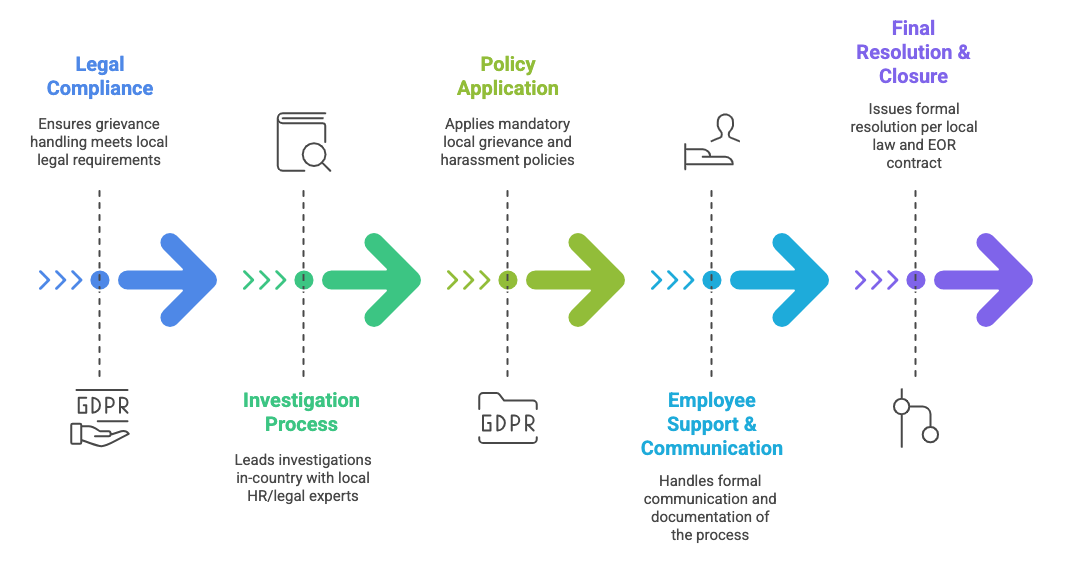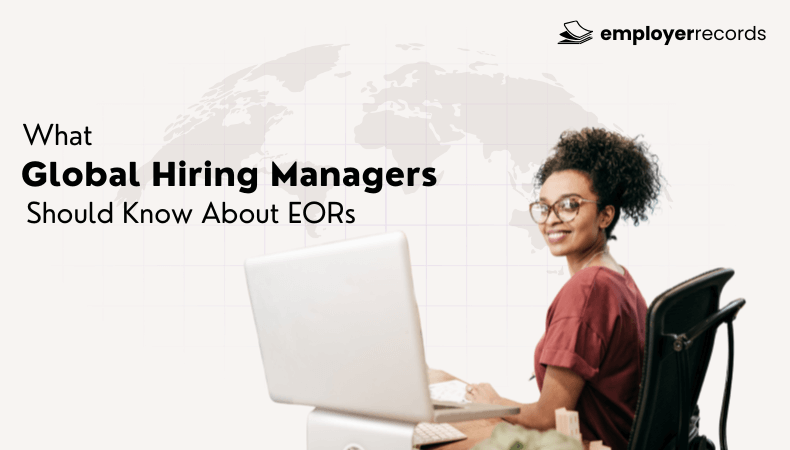An EOR is the legal employer for your people in the country where you don’t have an entity. On paper, the contract, payroll, and statutory compliance sit with them. In practice, the person works for you day‑to‑day. Good EORs describe it plainly: they run compliant employment and HR support, you run the business and culture.
Some even say the quiet part out loud: “We handle employee grievances and employee relations support.” That’s useful clarity, because complaints always test the edges of the partnership.
Think of grievance handling as a relay, not a handoff: the issue belongs to your company; the procedure must meet local law; the paper trail often needs the EOR’s letterhead.
This article walks you through how grievances actually get handled when an EOR is part of the mix. We’ll look at how roles get defined, and sometimes muddled, when issues arise.
You’ll see practical steps for clarity, real jurisdictional quirks that often trip teams up, and a simple playbook you can put into action immediately. If you’ve ever wondered who steps in when something goes sideways in your EOR setup, this is the roadmap you’ve been waiting for.
Key Takeaways
- EORs handle employee grievances in compliance with local labor laws, reducing the legal burden for global employers.
- A well-defined contract clarifies whether grievance handling falls under the EOR or the client company’s responsibility.
- Referencing official guidance like ACAS, the EEOC, or the POSH Act strengthens grievance processes and legal defensibility.
- Unexpected costs can arise from benefits, severance, or administrative fees, so due diligence on EOR pricing is critical.
- Proactive communication between the EOR, employer, and employee helps resolve issues early and avoid escalation.
What Qualifies As A “Grievance” Across Borders?
In most countries, a grievance is simply a formal complaint about something an employee believes is unfair or unlawful, such as bullying, harassment, pay errors, denied leave, manager conduct, safety, you name it. The formal process matters because it triggers specific steps and rights in many jurisdictions.
Take the UK. The government’s guidance says employers must set out a written grievance procedure, explain who to contact, and allow accompaniment in meetings. Tribunals can add or subtract up to 25% from awards if the ACAS Code of Practice wasn’t followed.
That’s not abstract; if your EOR‑hired employee in London raises a complaint, the process needs to line up with that Code.
ACAS, the UK’s advisory service, sets out in its official Code of Practice on Disciplinary and Grievance Procedures that employers should first attempt informal resolution where appropriate, followed by a fair investigation, a grievance hearing, a decision, and an appeal.
In India, sexual-harassment complaints are governed by the Sexual Harassment of Women at Workplace (Prevention, Prohibition and Redressal) Act, 2013 (POSH Act), which requires an Internal Committee when a workplace has 10+ employees.
The law prescribes timelines, the composition of the committee (including an external member), and reporting requirements.
If your developer in Bengaluru is employed through an EOR, the employer (the EOR on paper) still needs to ensure a compliant committee and process, typically in concert with you, since you control the daily work environment.
And in the U.S., the EEOC’s April 2024 updated harassment guidance emphasizes that employers should maintain clear complaint procedures, strong anti-retaliation safeguards, and effective training.
Even if the EOR is the legal employer abroad, your brand and managers are in the story, so your policies, training, and response culture still matter. Retaliation remains the most frequently cited basis for discrimination charges, making sloppy handling a business risk well beyond legal fees.
Who Picks Up The Complaint?
In real life, grievances come in three ways:
- To the manager: They’re closest to the problem.
- To your HR team: Because the employee identifies with your company.
- To the EOR: Especially when the issue feels “legal,” pay‑related, or sensitive.
A mature EOR setup includes a single intake path that both parties share: one mailbox or ticket type that notifies your HR lead and the EOR case manager. Whoever receives it first logs it, acknowledges it to the employee, and triggers a joint case plan.
Some EORs will lead the procedural steps and draft the letters (in the right language, with the right statutory citations), while you lead the fact‑finding and remedies in the actual team. That division keeps you compliant without turning the case into a game of telephone.
The Investigation: What “Good” Looks Like In An EOR Model
A fair investigation has the same bones everywhere: plan, gather facts, keep records, make a decision, offer an appeal, but the texture changes by country. Here’s how the work usually splits.
Grievance Handling Process

Case scoping
The EOR confirms which policies apply locally, the legal definition of terms (e.g., “bullying” in the UK vs. “hostile work environment” in the U.S.), and any statutory steps or timelines. ACAS‑style steps in the UK and formal written procedures mandated by the GOV.UK guidance are standard expectations.
Interviews and evidence
The EOR advises on scripts (what you must ask, what you must not), privacy notices, note‑taking standards, and whether a companion/representative is allowed or required. In regulated systems like the UK, allowing accompaniment is not optional.
Deciding the outcome
The EOR sanity‑checks the decision against local law and drafts formal outcome letters that can withstand agency scrutiny or tribunal review.
In India, POSH matters; for example, the Internal Committee’s findings drive the outcome and reporting; the EOR helps make sure that happens on time, with the correct format.
Appeal
The EOR pre-agrees a second‑level reviewer (often an EOR HR leader not previously involved, paired with your senior HRBP). That preserves fairness and meets common “appeal to a different person” expectations in European systems.
Where Companies Get Burned, Even With A Good EOR
Here’s where companies often stumble, even those working with reputable EORs:
Hidden and Mounting Costs
EORs often promise simplicity, but the bills can stack up fast. According to a report, nearly 42% of companies working with an EOR reported unexpected costs in the first year, including mandatory benefits and payroll.
Some EORs tack on foreign-exchange fees or inflate charges during exits. It’s not uncommon to find that the monthly fee you signed up for is just the tip of the iceberg.
Gaps in Service Quality and Understanding
EORs can be compliance experts, but sometimes their distance from your culture and business shows. An article I came across warns that EORs may not grasp your specific needs or operate with your tone, leading to misaligned service, miscommunication, or inconsistent handling of employee needs.
Audit Failures or Legal Non-Compliance
If the EOR slips up on country-specific rules, it can mean fines, penalties, or worse. Even though they’re the legal employer, your company can share liability, especially if policies don’t reflect local grievance procedures or labor codes.
Lagging Payroll and Poor Support
Few things make employees lose trust faster than delayed pay or bot-driven support. Imagine your HR team chasing the EOR for answers on payroll mistakes, with crickets. Not only is morale affected, but your HR team wastes time, and the employee experience takes a serious hit.
Damage to Your Brand
Mess up a contract or policy, and you won’t just annoy people, you’ll see it pop up on Glassdoor, LinkedIn, and whispered in industry circles.. In tight talent markets, that reputation hit hurts more than any fine.
Failure to Fix Root Issues
Let’s say an employee flags a recurring policy issue or a toxic work pattern. Address it superficially, and you’ll keep dealing with the same problem later.
Organizations (with or without EORs) often brush things under the carpet until they explode. A good grievance process tackles not just symptoms but root causes.
Jurisdiction Snapshots, So You Can Set Expectations:
Even when you’ve got a solid EOR partner, local rules, like grievance timelines, committee mandates, and documentation expectations, shift dramatically from one country to the next.
United Kingdom
- Process: Follow ACAS Code: investigate, hold a hearing, decide, allow appeal.
- Documentation: Written procedure shared with employees; accompaniment rights.
- Risk: Not following the Code can swing tribunal awards by up to 25%.
- EOR angle: The EOR anchors the formalities; you supply facts and remedies.
India (POSH)
- Process: Internal Committee (IC) required for sexual‑harassment cases; specific timelines and external member mandated.
- Documentation: IC minutes, inquiry report, and annual reporting.
- Risk: Non‑compliance can trigger penalties and reputational damage.
- EOR angle: The EOR, as legal employer, ensures a compliant IC exists and that the inquiry and reporting happen, even if practical steps (like reassigning a manager) sit with you.
United States
- Process: Clear complaint channels, prompt investigation, anti‑retaliation protections, and training aligned to EEOC guidance.
- Documentation: Policy acknowledgment, investigation notes, outcome letters.
- Risk: Retaliation findings and harassment allegations are stubbornly common.
- EOR angle: If you’re employing through an EOR in a U.S. state where you lack an entity, coordinate closely on state‑specific rules; you still own manager behavior and culture.
A Working Model You Can Run
Below are the steps on how to run a grievance process that works, even when you’re sharing HR duties with an Employer of Record.
Step 1. One front door for complaints: Create a single “employee relations” email (or HRIS case type) that notifies both your HRBP and the EOR case manager. Use an auto‑reply that sets expectations: receipt confirmed, next steps, timeline, and anti‑retaliation language.
Step 2. A 48‑hour investigation plan: By day two, agree in writing: the allegation summary, who interviews whom, what records you’ll pull, and when the outcome meeting will happen. In the UK, that also means clarifying the right to be accompanied; in POSH cases, confirming the Internal Committee schedule.
Step 3. Shared templates: Borrow the EOR’s localised letter and form templates so you don’t miss any legal must-haves, then tweak the language so it still sounds like your company, not a lawyer’s office.
Step 4. Retaliation safeguards: Flag the complainant and key witnesses in your HRIS for 90-180 days. Any material changes, such as hours, territory, or projects, get a second set of eyes.
Have managers write a one‑line justification for each change, just to make them think twice. The data shows why that’s worth the friction.
Step 5. A tidy case file: Ask the EOR to maintain the official case file (they’re the legal employer) and share a redacted copy to your archive. If you ever need to defend a decision, you’ll be glad the letters came on the right letterhead.
What About Anonymity And Whistleblowing?
A fair question. In Europe, many organizations now run internal reporting channels (with anonymity options) under national laws implementing the EU Whistleblower Directive.
Even when your EOR is the legal employer, it’s smart to offer a single reporting channel that can route appropriately, internally for ethics issues, to the EOR for employment‑law steps, or both.
Your EOR can host a country‑specific intake, but your brand should stand behind the channel culturally. (If you operate in the UK or India, remember: “whistleblowing” and “grievance” aren’t always the same thing; the right lane matters.)
The Cultural Side, The Part That Software Won’t Fix
A polished case template can’t save you from a manager who rolls their eyes when someone complains. Employees will choose the path that feels safest.
In EOR arrangements, distance makes that calculus complicated: “Do I tell my manager, HR, or this third‑party employer I’ve never met?” The answer is: make all three doors feel safe. That looks like:
- One intake that works, every time.
- A human acknowledgement within a day.
- Managers are trained to press pause on knee‑jerk decisions after a complaint.
- A visible pattern of fair outcomes; some upheld, some not, all explained.
None of that requires a 100‑page manual. It does require a shared playbook with your EOR and some steady repetition.
Quick Checklist To Sanity‑check With Your EOR This Week
A conflict rarely blooms from an intentional error. It grows when nobody’s quite sure who’s paying attention, or when messages land with silence. With this checklist, you’re not adding hoops, you’re building a lean, reliable safety net.
| Area | What to Ask or Verify |
| Shared Intake and Response SLAs | Confirm you’ve set up one unified channel for grievance intake that notifies both your HR lead and the EOR. Ensure acknowledgments go out within 24-48 hours. |
| Localized Procedure Templates | Ask to review the EOR’s country-specific grievance letters and invitation templates. Do they reference the right local rules, ACAS in the UK, POSH in India, EEOC guidelines in the U.S.? |
| Clear Role Mapping | Ensure both sides know who owns investigation steps: gathering facts (your responsibility), legal compliance, and documentation (EOR responsibility). |
| Documenting & Filing Standards | Ask the EOR if they maintain a full case file (intake, notes, evidence, outcome, appeal) and that you get a redacted copy for your records, just in case. |
| Retaliation Watch | Confirm whether key parties are flagged post-complaint for extra oversight. Ask if managers are trained to document any assignment changes with justifications. |
| Post-Case Debrief Plan | Establish a short post-resolution sync to identify what worked, what didn’t, and if any repeating patterns call for broader action. |
| Human Support Access | Can your HR team and end-users reach a real person when needed, not just bots? What’s the SLA for a meaningful response? |
| Compliance Grand Tour | Ensure the EOR is registered in each jurisdiction you hire, uses locally valid contracts, and offers clear pricing, no hidden fees. |
| Training and Prevention Measures | Ask how often they train your managers on grievance handling, anti-retaliation, and documentation best practices. |
Conclusion
At the heart of grievance handling with an EOR lies trust, not formality. When companies define roles clearly, stay responsive, and honor local rules, they turn complaints into conversations, not crises.
Whether that teammate’s in London, Bengaluru, or Austin, the point is they know someone’s actually listening, not just filing paperwork.
The real win with a good EOR isn’t just avoiding fines, it’s proving you can follow the law without losing the human touch.







